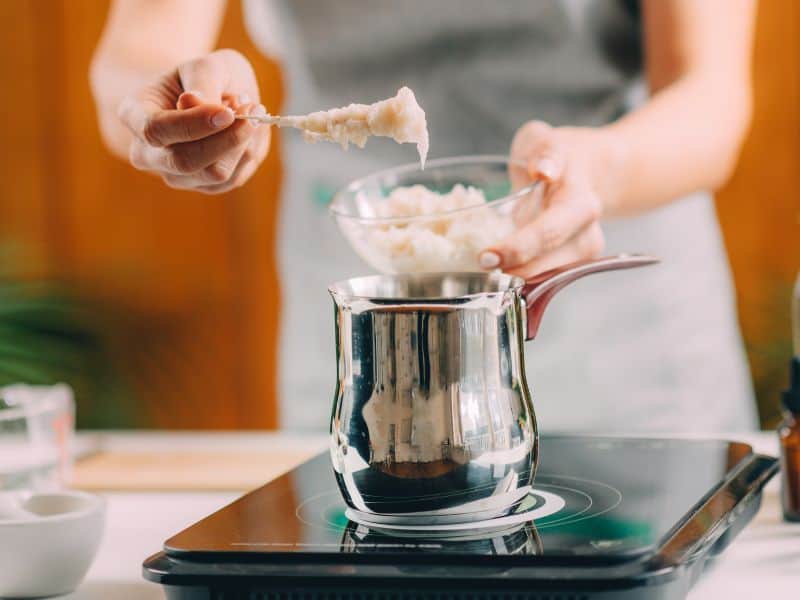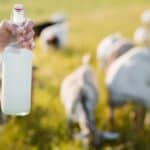Cold process soap making is an art form that combines creativity, chemistry, and craftsmanship. Achieving the perfect balance between these elements is key to producing beautiful, high-quality soaps. One crucial aspect of this process is understanding the trace stage, which can make or break your final product. We will explore what happens if you pour soap before trace, discuss the consequences of doing so, and provide valuable tips for troubleshooting issues.
Pouring soap before trace can result in incomplete saponification, uneven consistency, and issues with fragrance and color distribution. Achieving proper trace ensures a well-emulsified soap with consistent texture, balanced scent and color, and reduced risk of separation or spoilage.
For these reasons, it is important to understand how to identify and troubleshoot trace-related issues. When making cold process soap, trace is the moment when the soap begins to thicken and resemble pudding or thick honey. It happens during saponification, which is a chemical reaction between your oils and lye solution that produces soap.
Let’s take a closer look at trace and trace related issues below.
Consequences of Pouring Soap Before Trace
Incomplete saponification
Definition of saponification
Saponification is the chemical reaction that takes place when oils or fats are combined with an alkali, such as sodium hydroxide (lye), to produce soap. In cold process soap making, saponification occurs when the lye solution is mixed with the oils, and the trace stage is an indicator that this reaction is well underway.
Risks of using soap with unsaponified oils
Pouring soap before trace can lead to incomplete saponification, which means that not all the oils in the mixture have reacted with the lye. Using soap with unsaponified oils can cause several issues, including skin irritation and a greasy or oily residue on the skin.
Moreover, soap with a high percentage of unsaponified oils may spoil or develop rancidity over time, leading to an unpleasant odor and reduced shelf life.
Uneven consistency
Soft or crumbly texture
When soap is poured before trace, the mixture may not have the proper consistency for hardening and setting as it should. This can result in a soft, mushy, or crumbly texture, which makes it difficult to cut and handle.
A soap with uneven consistency may also be less effective in cleansing and may dissolve quickly in water, reducing its lifespan.
Difficulty in cutting and using the soap
A soap with uneven consistency can be challenging to cut into bars, as it may crumble or break apart easily. Additionally, using such soap can be frustrating, as it might not lather well or provide the desired level of cleansing.
In some cases, the soap may be so soft that it becomes unusable, leading to wasted time, effort, and resources.
Discoloration and fragrance issues
Fragrance and colorant migration
Pouring soap before trace can result in fragrance oils and colorants not being properly incorporated into the mixture. This may cause the fragrance and color to migrate or pool in certain areas of the soap, leading to an uneven distribution.
In some cases, fragrance oils may even separate from the soap, causing a strong, unpleasant odor in some parts, while other parts may be left with little or no scent.
Uneven scent and color distribution
An uneven distribution of scent and color can be aesthetically unappealing and can affect the overall user experience. Fragrances and colors play a significant role in the appeal of handmade soaps, and uneven distribution can result in a less desirable product.
Additionally, if the fragrance oils and colorants are not properly incorporated, they may not perform as expected, leading to inconsistencies in the soap’s scent and appearance throughout its use.
Understanding Trace in Cold Process Soap Making
Definition of trace
Trace is a crucial stage in the cold process soap making method, referring to the point at which the soap mixture has thickened enough to leave a visible trail when drizzled on the surface.
At this stage, the oils and lye have emulsified and saponification has begun, making it the ideal time to pour the soap mixture into the mold for curing.
How to identify trace
Thin trace
Thin trace is the first stage of trace, where the soap mixture has a thin, watery consistency. It is characterized by a barely visible trail left behind when the mixture is drizzled onto itself. At this stage, the soap is not yet ready to be poured into the mold, as it requires further mixing to achieve a proper emulsion.
Medium trace
Medium trace is the ideal stage for pouring soap into the mold. The mixture will have a thicker consistency, similar to that of a light pudding or custard. When drizzled on the surface, the trail left behind will be more distinct and remain visible for a few moments before sinking back into the mixture. This stage is perfect for most soap designs and techniques.
Thick trace
Thick trace occurs when the soap mixture has an even thicker consistency, resembling a heavy pudding or cake batter. At this stage, the trail left by drizzling the mixture is very distinct and remains on the surface without sinking back in.
While this stage is suitable for specific soap designs requiring a thicker consistency, it can be more challenging to work with due to the reduced fluidity.
Factors affecting trace
Recipe formulation
The choice of oils and fats, as well as the lye concentration, can significantly impact the rate at which trace occurs. Oils with a high percentage of saturated fats, like coconut oil or palm oil, tend to reach trace more quickly than those with higher unsaturated fat content, like olive oil or sunflower oil.
Temperature
The temperature of the oils and lye solution can also influence the speed at which trace is achieved. Higher temperatures generally result in a faster trace, while lower temperatures can slow down the process.
It is essential to monitor and maintain the ideal temperature for your specific recipe to ensure proper trace development.
Mixing method
The method used for mixing the soap ingredients can affect the trace as well. Hand stirring generally takes longer to reach trace compared to using a stick blender.
However, using a stick blender can sometimes result in an accelerated trace, making it essential to find the right balance of mixing speed and duration.
Importance of reaching trace before pouring
Reaching the appropriate trace stage before pouring the soap mixture into the mold is vital for several reasons. It ensures that the oils and lye have properly emulsified and saponification has started, resulting in a soap with even consistency, balanced fragrance and color distribution, and a reduced risk of separation or spoilage.
Skipping or rushing the trace stage can lead to the issues discussed in Section III, which can compromise the quality, appearance, and overall experience of using the finished soap.
Troubleshooting and Preventing Issues with Trace
Adjusting your soap recipe
Choosing the right oils and fats
Selecting the appropriate oils and fats for your soap recipe plays a significant role in achieving the desired trace. It’s essential to consider the properties of each oil, such as their fatty acid composition, and how they impact trace development.
Experimenting with different oil combinations can help you find the perfect balance for your soap, ensuring a proper trace and a high-quality final product.
Calculating the correct lye concentration
Using the right amount of lye is crucial to achieving the desired trace and ensuring complete saponification. Online soap calculators can help determine the appropriate lye concentration based on your choice of oils and desired superfatting percentage.
Always measure your ingredients accurately, and remember that safety precautions must be taken when handling lye.
Monitoring and controlling temperature
Importance of temperature in cold process soap making
Temperature plays a vital role in cold process soap making, as it can impact the rate at which trace is achieved and the overall quality of the finished soap.
Proper temperature control ensures a smooth and even trace, preventing issues such as false trace or accelerated trace.
Tips for maintaining the ideal temperature
To maintain the ideal temperature during soap making, consider the following tips:
- Use a thermometer to monitor the temperature of your oils and lye solution.
- Preheat or cool your oils and lye solution as needed to achieve the desired temperature range, typically between 90°F and 110°F.
- Keep your soap-making workspace at a consistent temperature, avoiding drafts or sudden temperature changes.
- Cover your soap mold with a towel or blanket after pouring to insulate it and maintain a consistent temperature during the curing process.
Perfecting your mixing technique
Hand mixing versus using a stick blender
While hand mixing can eventually bring your soap mixture to trace, it can be a time-consuming process. On the other hand, using a stick blender can significantly speed up the process.
However, it’s essential to be mindful of overmixing or accelerating trace with a stick blender. Alternating between hand stirring and using the stick blender can help strike the right balance.
Proper mixing speed and duration
The speed and duration of mixing can impact the trace development. Mixing too slowly may result in a prolonged process, while mixing too quickly can cause an accelerated trace, leaving little time to pour or work with the soap.
Practice and experimentation are key to finding the right mixing speed and duration to achieve the perfect trace for your recipe. Start by mixing at a moderate speed and gradually increase it if necessary, paying close attention to the changes in the soap mixture’s consistency.
Frequently Asked Questions
False trace is a premature thickening of the soap mixture caused by cooler temperatures, which can make it appear as though trace has been reached. To avoid false trace, ensure that the oils and lye solution are at the recommended temperature range (typically between 90°F and 110°F) before mixing.
Once trace has been reached, it cannot be reversed. However, you can continue to mix the soap to achieve a thicker trace if necessary.
Trace itself does not directly impact the curing time of soap. However, a properly emulsified soap mixture poured at the right trace stage will generally result in a more consistent, well-formed soap that cures evenly.
If your soap reaches trace too quickly, try to work with it as quickly as possible, pouring it into the mold or adjusting your design as needed. For future batches, consider adjusting your recipe, temperature, or mixing method to prevent accelerated trace.
While it is possible to pour soap at thin trace, it is not recommended, as it may result in incomplete saponification, uneven consistency, and issues with fragrance and color distribution.
A hand blender, also known as a stick blender, is commonly used to achieve trace more quickly than hand stirring alone. However, be cautious of overmixing or accelerating trace when using a stick blender.
Achieving the proper trace ensures that the soap mixture is well-emulsified, resulting in a consistent texture, even fragrance and color distribution, and an overall better-looking final product.
Medium trace, which has a consistency similar to light pudding, is the ideal stage for pouring soap into the mold. This stage is perfect for most soap designs and techniques.
Conclusion
In conclusion, understanding the trace stage in cold process soap making is essential for creating high-quality, consistent, and visually appealing soaps. Pouring soap before reaching trace can lead to incomplete saponification, uneven consistency, and issues with fragrance and color distribution. By carefully selecting the right oils and fats, maintaining the ideal temperature, and perfecting your mixing technique, you can ensure a proper trace and avoid potential pitfalls.
Don’t be afraid to experiment with different recipes and techniques to find the perfect balance for your soap creations. As you gain experience and knowledge, you’ll be better equipped to troubleshoot and prevent issues related to trace, ultimately resulting in beautifully crafted, high-quality soaps that you can be proud of.






